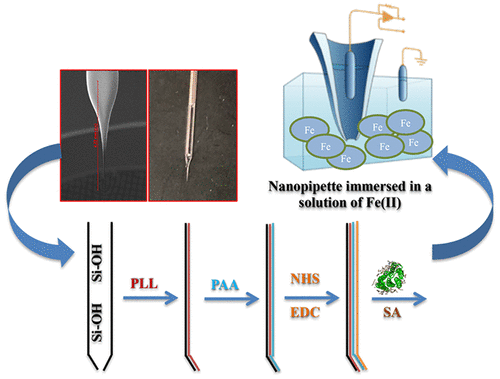当前位置:
X-MOL 学术
›
ACS Chem. Neurosci.
›
论文详情
Our official English website, www.x-mol.net, welcomes your feedback! (Note: you will need to create a separate account there.)
Employment of Iron-Binding Protein from Haemophilus influenzae in Functional Nanopipettes for Iron Monitoring.
ACS Chemical Neuroscience ( IF 5 ) Pub Date : 2018-10-26 , DOI: 10.1021/acschemneuro.8b00263 Gonca Bulbul 1 , Goksin Liu 2 , Namrata Rao Vithalapur 1 , Canan Atilgan 2 , Zehra Sayers 2 , Nader Pourmand 1
ACS Chemical Neuroscience ( IF 5 ) Pub Date : 2018-10-26 , DOI: 10.1021/acschemneuro.8b00263 Gonca Bulbul 1 , Goksin Liu 2 , Namrata Rao Vithalapur 1 , Canan Atilgan 2 , Zehra Sayers 2 , Nader Pourmand 1
Affiliation

|
Because of the serious neurologic consequences of iron deficiency and iron excess in the brain, interest in the iron status of the central nervous system has increased significantly in the past decade. While iron plays an important role in many physiological processes, its accumulation may lead to diseases such as Huntington's, Parkinson's, and Alzheimer's. Therefore, it is important to develop methodologies that can monitor the presence of iron in a selective and sensitive manner. In this paper, we first showed the synthesis and characterization of the iron-binding protein (FBP) from Haemophilus influenzae, specific for ferrous ions. Subsequently, we employed this protein in our nanopipette platform and utilized it in functionalized nanoprobes to monitor the presence of ferrous ions. A suite of characterization techniques: absorbance spectroscopy, dynamic light scattering, and small-angle X-ray scattering were used for FBP. The functionalized Fe-nanoprobe calibrated in ferrous chloride enabled detection from 0.05 to 10 μM, and the specificity of the modified iron probe was evaluated by using various metal ion solutions.
中文翻译:

在功能性纳米移液器中使用流感嗜血杆菌铁结合蛋白进行铁监测。
由于缺铁和大脑中铁过多的严重神经系统后果,在过去的十年中,对中枢神经系统铁状态的兴趣显着增加。尽管铁在许多生理过程中起着重要作用,但其积累可能导致诸如亨廷顿病,帕金森病和阿尔茨海默氏病的疾病。因此,开发能够以选择性和灵敏的方式监测铁的存在的方法学很重要。在本文中,我们首先显示了流感嗜血杆菌铁结合蛋白(FBP)的合成和表征,该蛋白对亚铁离子具有特异性。随后,我们将该蛋白质用于我们的纳米移液器平台中,并在功能化的纳米探针中利用它来监测亚铁离子的存在。一套表征技术:吸收光谱,动态光散射和小角度X射线散射用于FBP。在氯化亚铁中校准的功能化Fe-纳米探针能够检测到0.05至10μM,并且通过使用各种金属离子溶液评估了改性铁探针的特异性。
更新日期:2018-10-11
中文翻译:

在功能性纳米移液器中使用流感嗜血杆菌铁结合蛋白进行铁监测。
由于缺铁和大脑中铁过多的严重神经系统后果,在过去的十年中,对中枢神经系统铁状态的兴趣显着增加。尽管铁在许多生理过程中起着重要作用,但其积累可能导致诸如亨廷顿病,帕金森病和阿尔茨海默氏病的疾病。因此,开发能够以选择性和灵敏的方式监测铁的存在的方法学很重要。在本文中,我们首先显示了流感嗜血杆菌铁结合蛋白(FBP)的合成和表征,该蛋白对亚铁离子具有特异性。随后,我们将该蛋白质用于我们的纳米移液器平台中,并在功能化的纳米探针中利用它来监测亚铁离子的存在。一套表征技术:吸收光谱,动态光散射和小角度X射线散射用于FBP。在氯化亚铁中校准的功能化Fe-纳米探针能够检测到0.05至10μM,并且通过使用各种金属离子溶液评估了改性铁探针的特异性。



























 京公网安备 11010802027423号
京公网安备 11010802027423号